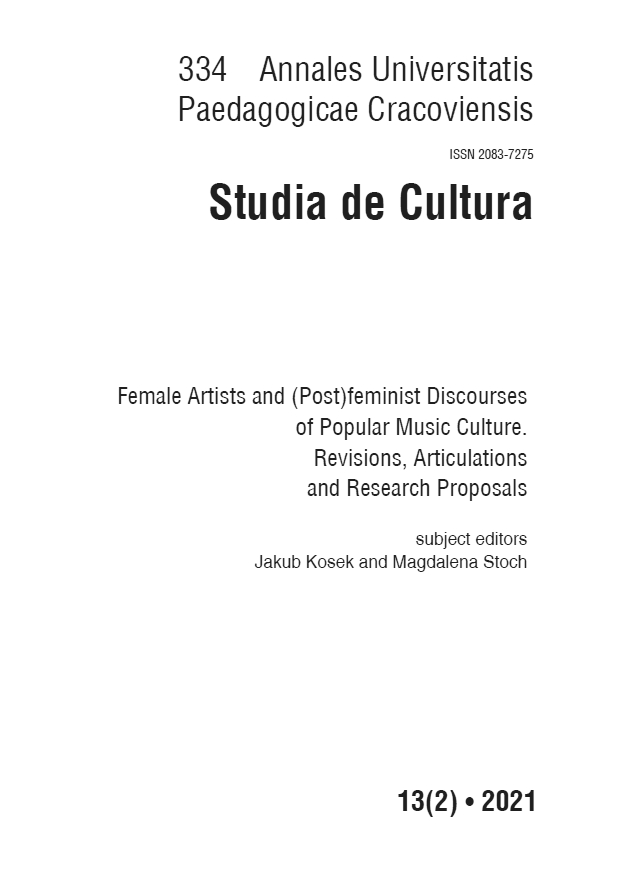Abstrakt
The presented volume of our journal focusses on the activity of selected female artists performing popular music. Even though it is obvious that the artistic achievements of female artists in rock, pop, metal, etc., have already been approached as an interesting research area within popular music studies, it is still a vast and inspiring field for analyses assuming various perspectives, including cultural, literary, musicological, media-oriented and sociological. In the opening article, Katharina Alexi investigates various contexts of glam rock, paying particular attention to currently rather forgotten female artists that represent this trend, such as Cherrie Vangelder-Smith and Bobbie McGee. The researcher accurately recognises the need to deepen interdisciplinary analyses of popular music so that they include the issue of power relations when it comes to the activities of less popular female glam rock artists. Konrad Sierzputowski is interested in the features of the trans(human) voices of singers known as Cher and Anohni. Referring to the cyborg metaphor (Donna Haraway) and Roland Barthes’ famous concept of the grain of the voice, the author attempts to show how the female voice may be used a form of critical resistance against the patriarchal and misogynistic vision of femininity. Jakub Kosek devotes particular attention to American female (heavy) metal artists whose artistic, stage and image endeavours largely employ provocation, scandalisation and ‘ceremonial profanation’ (vide Wendy Orlean Williams, Carla Harvey and Heidi Shepherd of the Butcher Babies). From the perspective of image (self)creation, the process of changeability and fluidity of the emploi proves interesting, especially in artistic activities of a subversive character. The volume also includes an article on media constructs of the groupies in the 1960s and 1970s. Karolina Karbownik discusses the role that groupies played in the creation of the myth and the figure of the god of rock, additionally taking into account the preconceived assumptions perpetuated by popular media. The author, also an active music journalist, analyses biographies of groupies, selected press materials and films to describe the place of groupies within the process of creating their identity within the rock culture. When it comes to the paper written by Dawid Kaszuba, it analyses the work of the American artist named Poppy, who uses grotesque to construct visual, auditory and lyrical emancipatory narratives expressing gender, personal and musical perspectives. The researcher discusses the manner in which Poppy’s self-consciousness as a singer deconstructs the image of the ‘metal woman’ by subversively combining hyper-feminine imagery with aggressive music and lyrics that engage, all of that done to expose the exclusionary paradigms that condition women operating in the metal genre. This issue of our journal contains one article slightly outside the leading and dominant theme of the activity of female music artists and feminist discourses in popular music. The text written by Emilia Cholewicka presents the socio-economic
situation of female choreographers in the male world of ballet art. The author analyses the labour market of Polish female choreographers working in leading ballet companies, pointing out the inequalities between women and men working on ballet choreography. The biography of Mira Kubasińska, a highly important artist in the history of Polish popular music, especially blues rock, is presented by Wojciech Kwieciński. The author is chiefly interested in career development of this cult singer and evolution of her artistic image in the years 1963-1973 on the domestic scene. Further in this issue, Paulina Łyszko focuses on selected questions concerning the body in feminist narratives of several pop artists of the young generation. While analysing chosen songs and music videos by, among others, Taylor Swift and Miley Cyrus, from the perspective of pop-feminism and physicality in the media, the author draws attention to the social involvement of young female artists as their artistic narratives raise issues concerning social inequality, fat shaming, slut shaming, stereotyping the disabled and transsexuals, the role of a mother in society or the objectification of the female body. The issue also present reports on two fascinating and valuable scientific events. Andrzej Mądro, being an active participant, succinctly presents discussions unfolding at the international scientific conference “Progect 2021. Towards a Contemporary Understanding of Progressive Rock and Metal”, hosted online on 19-21 and 26-28 May 2021. The main organiser of the conference was the University of Ottawa (Canada). The issue ends with a report concerning the interdisciplinary scientific conference “Cyberkultura 3.0. Aspekty medialne, kulturoznawcze, psychologiczne, prawne,” hosted online on 17-18 June 2021, thanks to the involvement of researchers from the Institute of Polish Philology and the Institute of Law and Economics at the Pedagogical University of Krakow (Poland). We hope that this issue of our journal delivers to the Readers an inspiring collection of texts devoted to the multithreaded, extensive and stimulating subject of the activities of female music artists and other important, although often marginalised, female figures present in popular music culture. We cordially invite you to read this volume.
Bibliografia

Utwór dostępny jest na licencji Creative Commons Uznanie autorstwa – Użycie niekomercyjne 4.0 Międzynarodowe.

